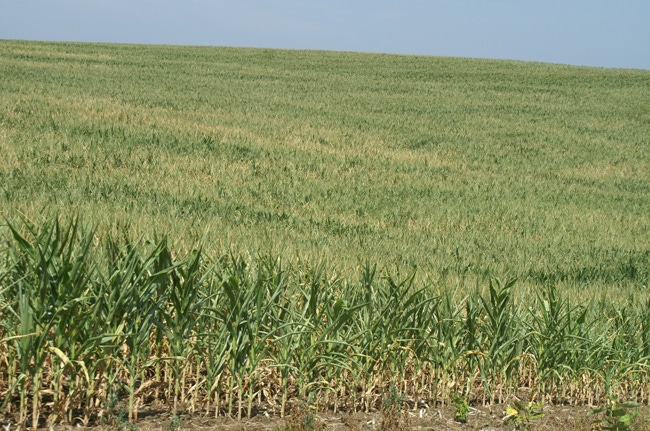August 16, 2012

Many producers are wondering whether the development of genetically modified hybrids and the improvement in hybrid yield potential and stress tolerance has made the corn crop more “drought-proof” now than it was in 1988.
Emerson Nafziger, a professor of crop sciences at the University of Illinois, said that as the drought worsened over the past weeks, he was regularly asked how this year’s yields are likely to be affected and how they will compare with the yields after the 1988 drought.
On August 10, the U.S. Department of Agriculture’s National Agricultural Statistics Service (NASS) projected that the 2012 Illinois corn yield would be 116 bu. per acre, an estimate that Nafziger said could still change. Projected yields range from 143 bu. in the Northwest Crop Reporting District (CRD) to 80 bu. in the East Southeast CRD.
In 1988, the average Illinois corn yield was 73 bu. per acre, and yields ranged from 87 bu. in the southeast (actually higher than the estimate of 86 bu. for this year in that CRD) to only 63 bu. in the northwest.
“The pattern of dryness in Illinois was very different in the two years, with southern Illinois relatively better than northern Illinois in 1988,” Nafziger noted. “In 2012, dryness was more evenly distributed, which led to a closer correlation between soil water-holding capacity and yields.”
To look at how much yield was lost to drought each year, Nafziger projected trend line yields for each of the drought years based on yields over the 30 previous years. The expected yield (trend line) for 1988 was 129 bu. per acre, and the actual yield that year was 73, so the loss was 56 bu. per acre. In 2012, the expected yield was 173 bu. per acre, and the estimated yield is 116, so the projected loss is 57 bu.per acre.
The 1988 yield represents a loss of 44% of expected yield, while in 2012, with higher yield expected, the percentage loss is only 33%. “In relative terms, the 2012 crop lost less yield than the 1988 crop, but in absolute terms, losses were almost identical for the two years,” said Nafziger.
It is clear that drought continues to cause serious yield loss, even with today’s faster-growing, higher-yielding hybrids.
“We don’t yet know if hybrids that have been improved specifically for drought tolerance will be less affected by drought this year, but it’s unlikely that any hybrid will produce high yields in areas and soils where most well-managed fields yield little or nothing,” said Nafziger.
Nafziger advises producers to take note of any hybrids that do relatively — and consistently — better than other hybrids under dry conditions, but cautions against overreliance on data from this year. “As we don’t know what next year will bring, we also need to include in our comparisons relative hybrid performance under better conditions, even if those come from last year or from 50 or 100 miles away,” he said.
“In other words, data from drought-affected comparisons predict best for drought conditions,” he said. “Because we have no reason to expect drought in 2013, we can keep this year’s results in the mix, but we should rely more on data from better-yielding trials to choose hybrids.”
You May Also Like




